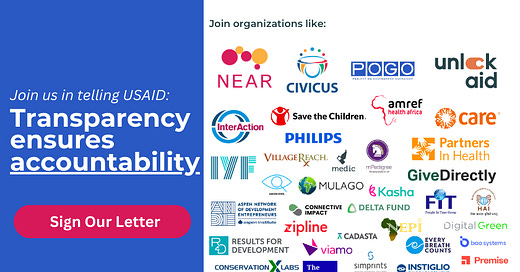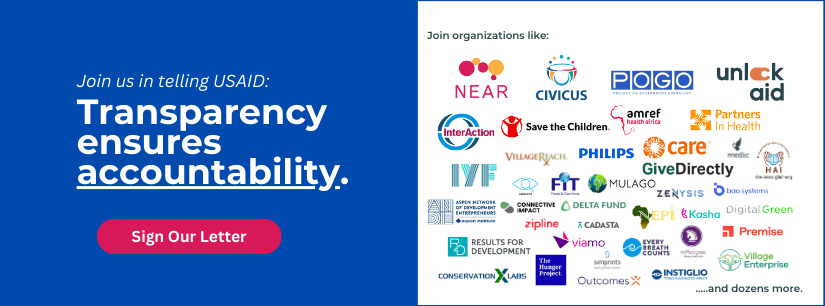Dear Unlock Aid community,
Last week, we co-signed an open letter to USAID and Administrator Power, calling on the agency to make more of its funding data publicly available. We co-signed this letter along with the coalitions NEAR and CIVICUS, which collectively represent tens of thousands of organizations around the world, the government accountability group Project on Government Oversight (POGO), and dozens of other organizations.
You can sign, too, either individually, on behalf of an organization, or both.
As NEAR explained, “Transparency is the only way we can track implementation of USAID’s commitments to ensure localisation remains a priority.”


CIVICUS put it this way, “Transparency holds @USAID accountable to commitments made to get more resources directly to local organizations and frontline innovators.”


Here’s why we co-signed:
Unlock Aid envisions a world where frontline organizations solving global development challenges can directly access resources from agencies like USAID. That’s why we support Administrator Power’s pledge to direct at least 25 percent of USAID resources to local organizations by 2025. But we’re running out of time to meet the deadline. More public, routine, and transparent reporting on progress made to meet the 25 percent target, disaggregated by geography and sector, will serve as an essential accountability tool.
Transparency must serve as an important accountability tool in subcontracting, too
Despite decades of well-intended reforms to diversify the agency’s partner base, most agency funding still flows through its largest legacy partners. This means subcontracting is still the only way for most other types of groups to work with USAID. But local organizations and frontline innovators who don't know how to play know the insider game of government contracting tell us that many of USAID’s largest partners too often cut them out of promised work.
One Kenyan organization told us they had to close one of their offices and lay off staff as a result of these practices. Another told us, “If we don’t see changes soon, we’re out… We are so disenchanted with this sector. We are losing our ability to work in it.”
Transparency can serve as an important accountability tool. By requiring contractors holding large grants and contracts to publish up-front the percent of funding they promised they’d sub-award to smaller partners (and especially local organizations) side-by-side with quarterly updates on what they actually disbursed, smaller organizations could identify which larger partners were the most likely to keep their promises.
Transparency builds the case for Congress to support the reform agenda
Barring security and safety concerns, by making all of USAID’s award data publicly available, including detailed budget information, work plans, and quarterly progress reports, USAID can help Congress and the American public better understand that working directly with local organizations and more nimble innovators is a far more cost-effective, higher-impact way to spend limited foreign aid dollars.
Making more information publicly available – such as funding data to show the gap between countries’ needs side-by-side with what Congress appropriates – would also bolster the case to lawmakers that USAID needs more funding flexibility and the workforce to get more resources to the right places.
Common-sense transparency proposals will go a long way towards improving the quality, equity, and effectiveness of U.S. foreign aid.
To progress,
Unlock Aid



